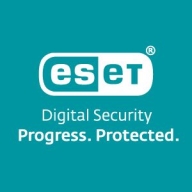

Elastic Security and ESET PROTECT Enterprise compete in the cybersecurity sector with each offering unique advantages. Elastic Security seems to have the upper hand due to its cost-effective pricing and strong integration capabilities, whereas ESET PROTECT Enterprise's robust feature set and comprehensive security solutions stand out, despite potentially higher costs.
Features: Elastic Security is known for data integration, threat detection, and real-time monitoring capabilities. It integrates smoothly with existing tools, providing seamless operation. ESET PROTECT Enterprise offers robust endpoint protection, advanced threat intelligence, and extensive management tools providing a full-fledged security suite.
Room for Improvement: Elastic Security could improve its learning curve and better its documentation for users. Making usability easier is another area of focus. ESET PROTECT Enterprise users suggest adding flexible configuration options and quicker response times to inquiries. Expanding customization features could enhance user satisfaction further.
Ease of Deployment and Customer Service: Elastic Security is noted for a straightforward deployment process, although there are requests for improved customer service onboarding. ESET PROTECT Enterprise, although needing expert oversight during setup, wins points for helpful and timely customer service once deployment is complete.
Pricing and ROI: Elastic Security is appreciated for its competitive pricing and the positive return on investment made possible by its open-source components and low initial costs. ESET PROTECT Enterprise, though pricier in setup, is viewed as offering strong return on investment due to its extensive security suite and operational efficiencies.
It does not require hefty security budgets and can be deployed for enterprise security effectively.
The return on investment is excellent due to its functionality and ease of installation.
There was money saving from using ESET PROTECT Enterprise, which is why I switched from CrowdStrike to ESET.
Most of the time when my team encounters issues, they receive responses within 24 hours.
Support is prompt and helpful.
The tech support from ESET is amazing, and I would rate it as ten out of ten.
My experience with ESET's technical support is positive; the technicians are knowledgeable and responsive.
Even if support is addressing my problem, if the two issues I mentioned are not resolved, then the support process is not complete.
It allows us to think about specific use cases, such as gathering malicious IPs in a single view and analyzing threats based on geolocation.
It can efficiently scale up to thousands of devices in an organization without issues.
I have used many products before, and this solution is definitely scalable.
It is better suited for workstations rather than server environments.
In terms of stability, I would rate Elastic a solid eight out of ten.
When it performs an update, ESET PROTECT Enterprise should request permission for restarting because otherwise, users lose their work.
The solution is stable, and I have not encountered any glitches.
The solution is very, very stable.
CrowdStrike and Defender have more established threat intelligence integration due to having a larger client base.
My security testing team continuously reports vulnerabilities, and we have to fix and update the versions frequently.
Elastic Security consumes a lot of resources, requiring a substantial deployment setup.
Sometimes, agents lose connection with the management console, and the administration team needs to reinstall the agents on the computers.
They need to reduce the number of notifications on the endpoints.
ESET PROTECT Enterprise makes the system a little slow sometimes and updates occur at startup.
The pricing is reasonable, especially for Small Medium Enterprises (SMEs), making it a viable option for businesses building their security infrastructure.
This is beneficial for SMEs as they do not need extensive budgets for security solutions.
Elastic Security is considered cost-effective, especially at lower EPS levels.
I pay 40 dollars per agent annually, which is cheaper than 60 dollars per agent for Check Point.
We recently paid fourteen dollars and thirty-six cents per unit for 20 users, which is reasonable.
Comparing it to other solutions in the market, it was slightly higher.
The platform provides more visibility and requires less effort in monitoring.
We require rapid processing speed for alerts and event data, and Elastic Security is very efficient at handling this level of data.
Elastic Security is as flexible and configurable as Microsoft Sentinel.
It allows simple whitelisting and has a learning mode for new installations, which reduces false positives by adapting to typical user habits.
Its web component prevents infections from malicious websites, which enhances its anti-malware capabilities.
This is a benefit because with all the systems connected, wherever the users are, from my system I can see what's happening on their system.
| Product | Market Share (%) |
|---|---|
| Elastic Security | 4.8% |
| ESET PROTECT Enterprise | 0.9% |
| Other | 94.3% |


| Company Size | Count |
|---|---|
| Small Business | 40 |
| Midsize Enterprise | 11 |
| Large Enterprise | 14 |
| Company Size | Count |
|---|---|
| Small Business | 11 |
| Midsize Enterprise | 2 |
| Large Enterprise | 2 |
Elastic Security combines the features of a security information and event management (SIEM) system with endpoint protection, allowing organizations to detect, investigate, and respond to threats in real time. This unified approach helps reduce complexity and improve the efficiency of security operations.
Additional offerings and benefits:
Finally, Elastic Security benefits from a global community of users who contribute to its threat intelligence, helping to enhance its detection capabilities. This collaborative approach ensures that the solution remains on the cutting edge of cybersecurity, with up-to-date information on the latest threats and vulnerabilities.
ESET PROTECT Enterprise ensures real-time visibility for all endpoints as well as full reporting and security management for all OSes
We monitor all Extended Detection and Response (XDR) reviews to prevent fraudulent reviews and keep review quality high. We do not post reviews by company employees or direct competitors. We validate each review for authenticity via cross-reference with LinkedIn, and personal follow-up with the reviewer when necessary.